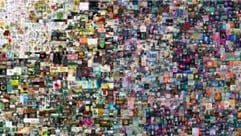Lately, much has been heard about NFTs, acronyms that refer to Non-Fungible Tokens. This token works as a digital certificate of authenticity through Blockchain, although it seems like a simple function, it has the power to revolutionize the digital world and open new lines of business.

NFTs are not a current innovation, they have been around for several years. It wasn’t until 2021 that its use expanded. As a result of experimentation with the Metaverse and the need to protect and monetize the digital creative world, artists, museums, companies from different sectors and professionals have begun to use it to protect and monetize their works in the digital world. Today it has such an impact that the buying and selling of NFTs is a market that exceeds one trillion dollars.
NFTs application areas
The most popular NFTs applications today are those corresponding to unique objects such as art pieces or historical relics. However, it is beginning to expand into a variety of niches that need the security, transparency, and protection, that this certificate provides. Just as a certificate guarantees that a numismatic coin has the guaranteed characteristics, NFTs rely on Blockchain technology to guarantee their properties.
Now we will see current NFTs application areas and some that soon will be:
Digital art: Artists use NFTs to auction their works and guarantee the buyer that they have purchased an original. Blockchain ensures transparency to transfer the property with all the rights to the buyer to freely expose or sell it.

Beeple: “The First 5,000 Days”
Digital History: The internet is part of society; therefore, it builds over time events that shape the world we live in. As in the physical world, the preservation and value of events and pieces that have been relevant in our timeline take on monetary and emotional values.
- The first tweet in history was auctioned by Jach Dorsey, CEO and founder of Twitter for more than 2.5 million dollars. This file is NFT protected as original with the date and time when it was created. Thus, it could be sold with real and historical value.
Collectibles: The collectible products’ originality and preservation are relevant for people who are fond of this activity. NFTs can also work with physical products, being a tool to certify their authenticity.
- 3,000 Pokemon card NFTs were sold for over $5 million. As with stickers, or any collectible, originality, and the possibility to exchange them after the sale with other collectors, make them extra attractive. Following this event, more card collections have begun to emerge that fetch an even higher value.
NFTs in video games: There are already several online games in which items purchased in-game with real money earn NFTs.
- For example, If I have a sword in a videogame I no longer use, this sword is not lost. The player can go to the game’s selling platform and sell it for real money so that another player can play with it. There are game platforms that even allow exchanging items between different games. This is possible by NFT and has a highly demanded interoperability. This is undoubtedly the future of this technology, being able to exchange them between different games or Blockchain platforms.
NFT and the Metaverse: Meta development and NFTs are interconnected. It should be noted that Meta (previous Facebook) seeks to absorb everything related to the Metaverse using its cryptocurrency and certifications. No doubt this vision could result in a whole new era of NFTs that remains to be seen.
Real estate: The purchase/sale of real estate can greatly benefit from the use of NFTs and Blockchain technology in general. Imagine being able to buy a house without having seen it. The photographs or videos together with the corresponding documentation guarantee that the property is without liens, debts, or pending taxes. All are included in a single file that when purchased, transfers ownership and corresponding registration in a single click. This could speed up transactions, at the same time, give the buyer more purchase security. This process would make transactions much easier in terms of bureaucracy. The legal regulations to transfer rights so easily have yet to be developed, but we are certainly moving towards it.
Secondhand market: From secondhand cars, through evening dresses, to home furnishings, NFTs can guarantee that the object is what is offered. It would no longer be necessary to check the mileage of a secondhand car, through the NFT we would obtain the car with all the documentation of the revisions, its previous users, accidents, etc. The simplicity of the process would allow transactions, flexibility and promote more sustainable use of everyday objects.
Fresh food: When we are buying an NFT, we are also buying the guarantee that the product is what it really claims to be. Fresh products such as fruit, vegetables, meat, and fish are often advertised through retouched and distorted advertising images to make them look perfect. Once the fresh product is in the hands of the consumer, disappointment arises due to the difference between the advertisement and the real product. This happens continuously on fresh products online purchases. An alternative is to incorporate an NFT system for fresh products that certifies that it is exactly as the customer is purchasing.
NFT is an expression of Blockchain technology. Its uses are still limited, probably due to a lack of legal and social regulation. As these aspects evolve, it will become more common to use NFTs in any type of transaction. Surely, this is just the beginning and NFT will evolve, combining with more innovative systems to reach new and better uses. Blockchain technology is far from having unleashed its full potential.


